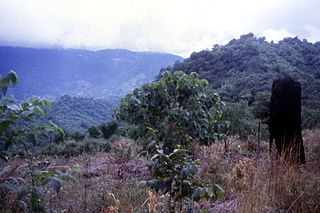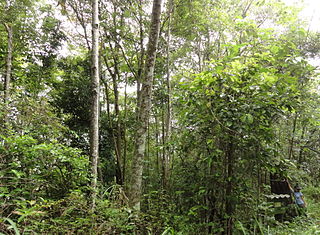


Forest restoration is defined as "actions to re-instate ecological processes, which accelerate recovery of forest structure, ecological functioning and biodiversity levels towards those typical of climax forest",[1] i.e. the end-stage of natural forest succession. Climax forests are relatively stable ecosystems that have developed the maximum biomass, structural complexity and species diversity that are possible within the limits imposed by climate and soil and without continued disturbance from humans (more explanation here). Climax forest is therefore the target ecosystem, which defines the ultimate aim of forest restoration. Since climate is a major factor that determines climax forest composition, global climate change may result in changing restoration aims.[2] Additionally, the potential impacts of climate change on restoration goals must be taken into account, as changes in temperature and precipitation patterns may alter the composition and distribution of climax forests.[3]
Forest restoration is a specialized form of reforestation, but it differs from conventional tree plantations in that its primary goals are biodiversity recovery and environmental protection.[4][5]
Forest and landscape restoration (FLR) is defined as a process that aims to regain ecological functionality and enhance human well-being in deforested or degraded landscapes.[6] FLR has been developed as a response to the growing degradation and loss of forest and land, which resulted in declined biodiversity and ecosystem services.[6] Effective FLR will support the achievement of the Sustainable Development Goals.[6] The United Nations Decade on Ecosystem Restoration (2021–2030) provides the opportunity to restore hundreds of millions of hectares of degraded forests and other ecosystems.[6] Successful ecosystem restoration requires a fundamental understanding of the ecological characteristics of the component species, together with knowledge of how they assemble, interact and function as communities[7]
- ^ Elliott, S., D. Blakesley and K. Hardwick, in press. Restoring Tropical Forests: a Practical Guide. Kew Publications, London
- ^ Sgró, C.M., A. J. Lowe and A. A. Hoffmann, 2011. Building evolutionary resilience for conserving biodiversity under climate change. Evolutionary Applications 4 (2): 326-337
- ^ Hoegh-Guldberg, Ove; Bruno, John F. (2010-06-18). "The Impact of Climate Change on the World's Marine Ecosystems". Science. 328 (5985): 1523–1528. Bibcode:2010Sci...328.1523H. doi:10.1126/science.1189930. ISSN 0036-8075. PMID 20558709. S2CID 206526700.
- ^ Lamb, David (2011). Regreening the Bare Hills. World Forests. Springer. p. 547. ISBN 978-90-481-9870-2.
- ^ Stanturf, John A. (2005). "What is forest restoration?". Restoration of boreal and temperate forests. Boca Raton: CRC Press. pp. 3–11. Archived from the original on 2017-07-04. Retrieved 2012-06-17.
- ^ a b c d "Restoring the Earth – The next decade". Unasylva. 71 2020/1 (252). FAO. 2020. doi:10.4060/cb1600en. ISBN 978-92-5-133506-2. S2CID 241374524.
- ^ Pywell, Richard F.; Bullock, James M.; Roy, David B.; Warman, Liz; Walker, Kevin J.; Rothery, Peter (February 2003). "Plant traits as predictors of performance in ecological restoration: Plant traits as predictors of performance". Journal of Applied Ecology. 40 (1): 65–77. doi:10.1046/j.1365-2664.2003.00762.x.